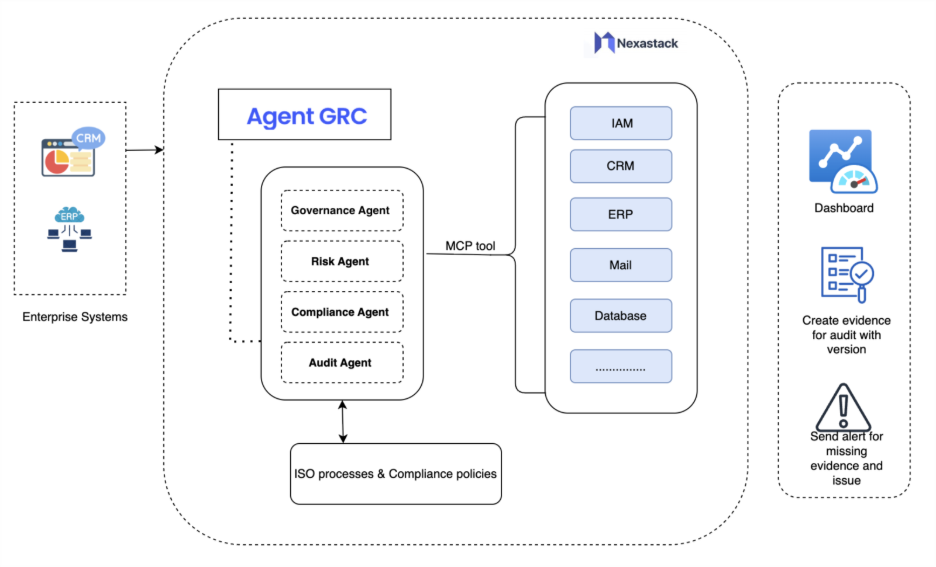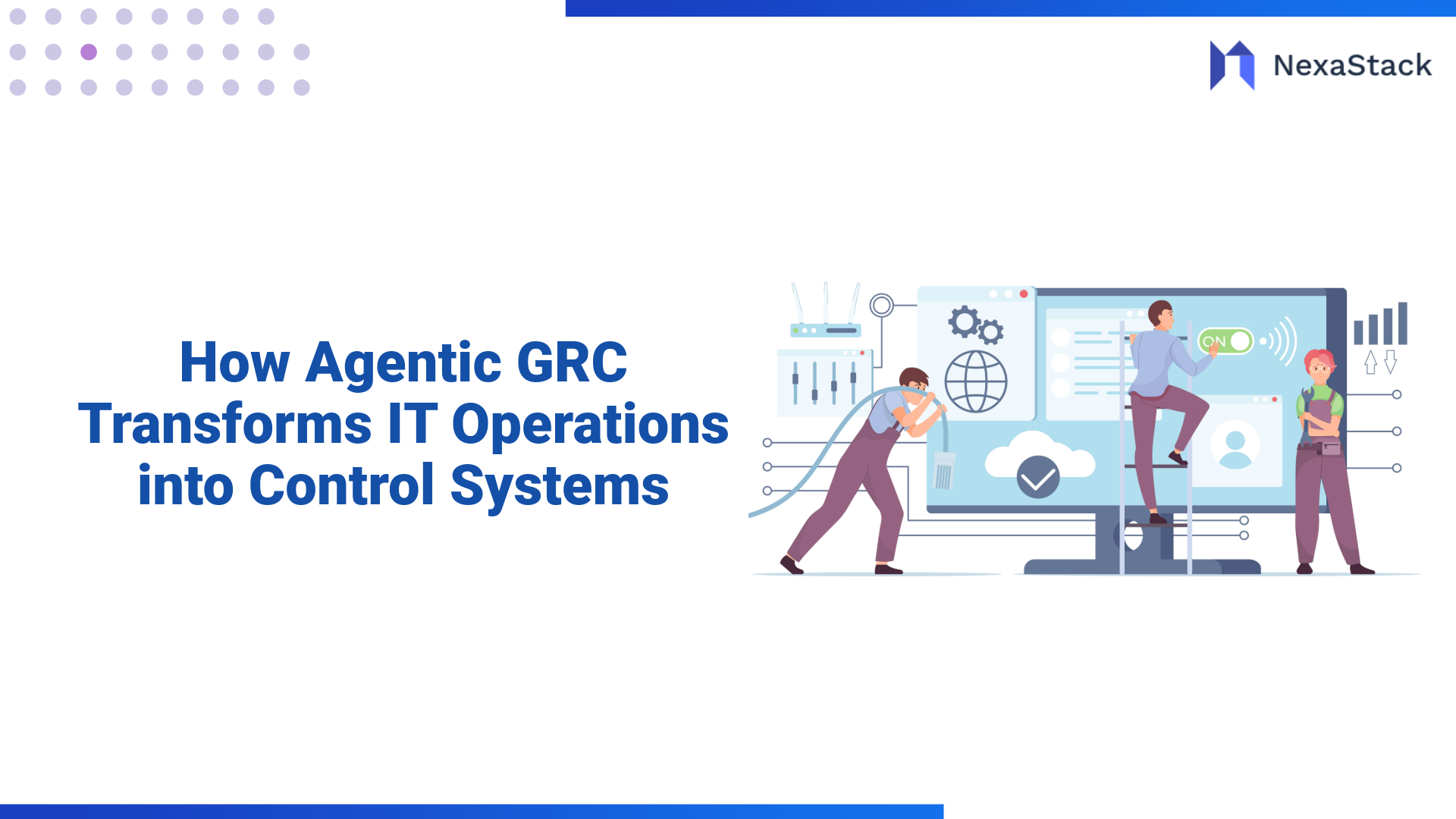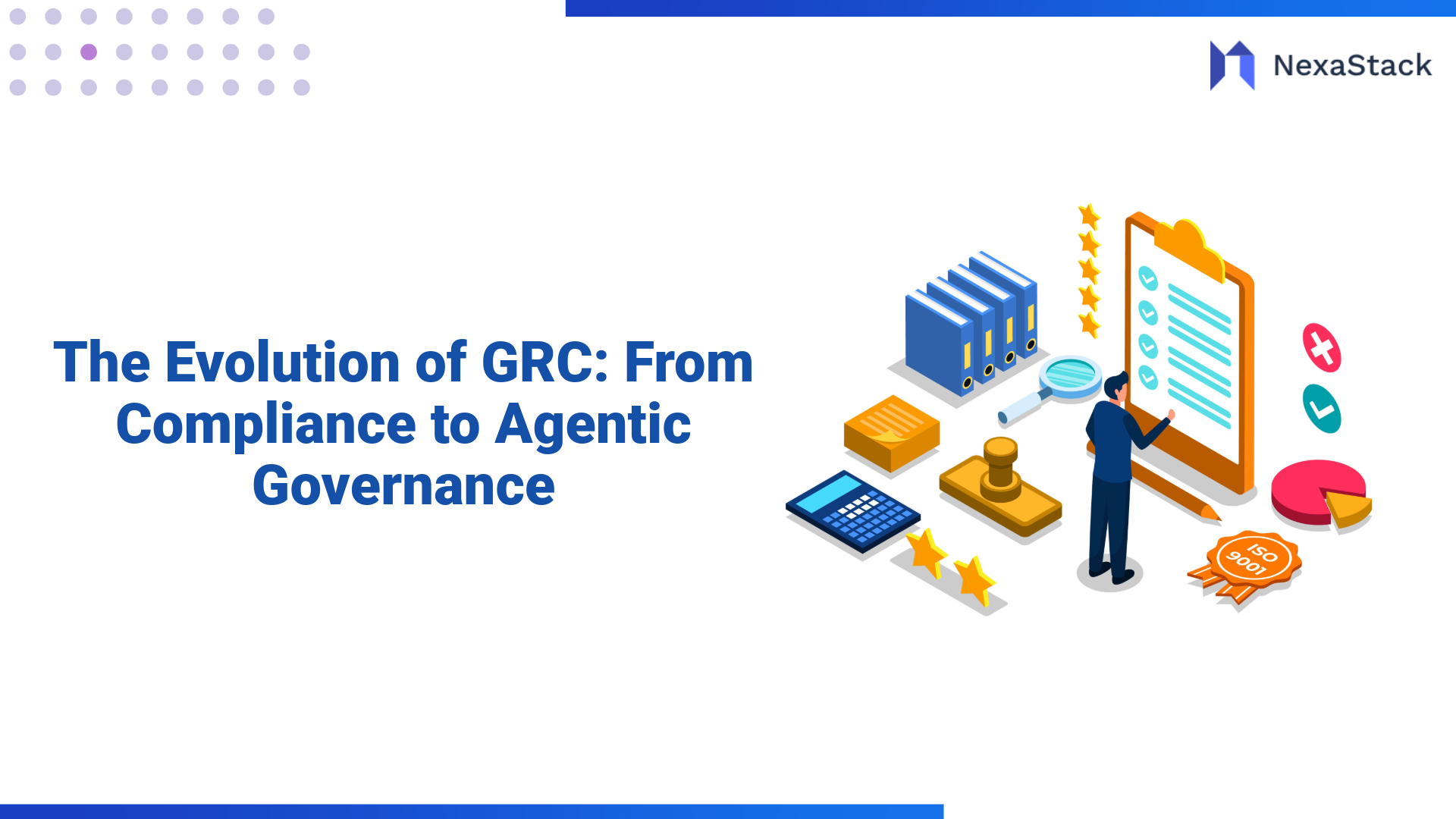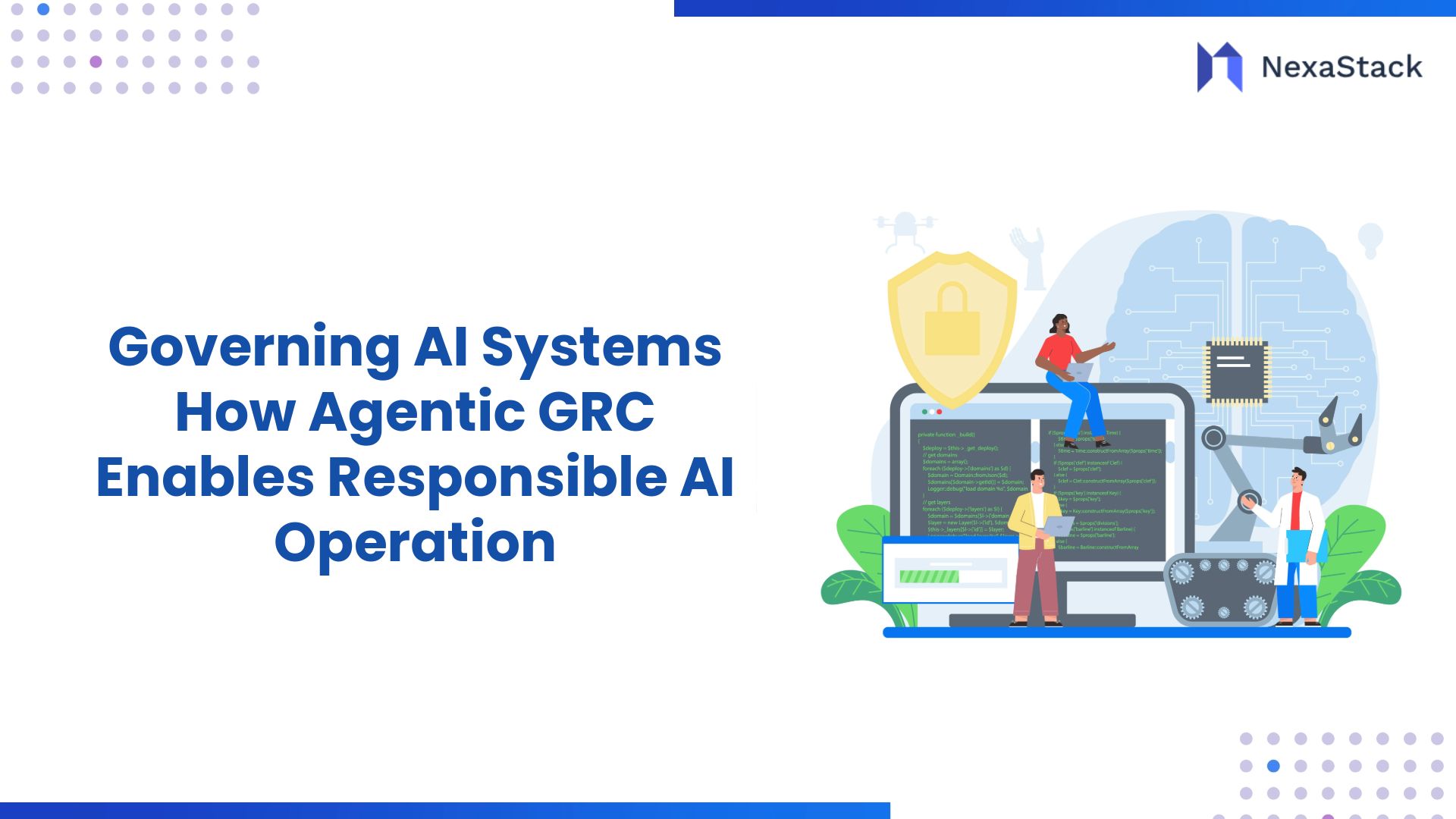Governance, Risk, and Compliance (GRC) has always been the backbone of organizational accountability — ensuring that decisions align with laws, ethics, and strategic objectives. But in today’s hyper-connected world driven by AI, automation, and real-time decision-making, traditional GRC systems have reached their limits.
Static policies, manual audits, and reactive compliance can no longer keep pace with the velocity of digital risk. Enterprises today demand a living governance framework — one that is intelligent, adaptive, and continuously operational.
This is where Agentic GRC comes into play. Built on autonomous AI agents, Agentic Governance represents a paradigm shift from checklists to self-governing digital ecosystems. Platforms like NexaStack make this transformation possible by embedding governance logic directly into AI agents that monitor, assess, and act in real-time.
By fusing automation, reasoning, and human oversight, NexaStack enables what every enterprise needs: continuous assurance, not periodic compliance.
What is Agentic GRC and How It Differs from Traditional GRC
Traditional GRC was designed for an era of spreadsheets, annual audits, and siloed compliance teams. It was effective for governance as a static process — but not for governance as a dynamic ecosystem.
Agentic GRC, on the other hand, transforms GRC into a self-evolving, intelligent layer within the enterprise. It integrates AI agents that can interpret policies, correlate risk signals, predict failures, and autonomously take corrective actions — all under the guidance of human supervision.
Here’s how the evolution looks in practice:
|
Dimension |
Traditional GRC |
Agentic GRC (via NexaStack) |
|
Governance Model |
Manual oversight and static reporting |
Autonomous agents enforce dynamic policies |
|
Risk Detection |
Periodic, audit-based |
Continuous, predictive risk modeling |
|
Compliance Management |
Reactive (after incidents) |
Proactive and real-time assurance |
|
Data Handling |
Fragmented and human-driven |
Unified, AI-orchestrated governance mesh |
|
Scalability |
Limited to team bandwidth |
Infinitely scalable via autonomous agents |
|
Outcome |
Checklists and reports |
Continuous assurance and digital trust |
NexaStack’s Agent GRC framework operationalizes these capabilities by utilizing autonomous AI agents that are pre-trained with governance ontologies, compliance schemas, and reasoning workflows. The system not only tracks but anticipates risk, closing the loop between governance policy and intelligent execution.
The Role of Autonomous Agents in Modern Governance
The foundation of Agentic GRC lies in the autonomous agent architecture — modular AI entities capable of sensing, reasoning, and acting across an organization’s data and process landscape.
 Fig 1.2. NexaStack Agentic Governance Architecture
Fig 1.2. NexaStack Agentic Governance ArchitectureOn NexaStack, these agents form an intelligent governance mesh:
-
Governance Agent – Defines and enforces organizational policies, linking regulatory requirements (e.g., ISO 27001, GDPR) to operational workflows.
-
Risk Agent – Continuously analyzes event streams, IoT telemetry, logs, and business indicators to assess real-time risk exposure.
-
Compliance Agent – Monitors adherence to standards, detects policy deviations, and triggers automated remediation actions.
-
Audit Agent – Creates immutable audit trails, ensures evidence traceability, and maintains always-on audit readiness.
These agents communicate seamlessly, forming an agentic orchestration layer that operates 24/7 — eliminating the need for batch reviews or quarterly assessments.
For example, if a security misconfiguration is detected, the Risk Agent immediately identifies it, notifies the Compliance Agent, which validates the issue and triggers a corrective workflow — all while the Audit Agent logs the entire process for evidence.
This is the NexaStack advantage: a fully autonomous yet transparent governance ecosystem where every event, decision, and remediation is governed intelligently.
Data Protection, Privacy, and Trust in Agentic Systems
As governance becomes agent-driven, data protection and trust become the defining pillars of governance. NexaStack embeds Privacy-by-Design principles at every layer of the Agentic GRC architecture.
1. Transparent Data Lineage
Every action performed by an agent — from data collection to decision — is logged and traceable. This ensures explainability and auditability, crucial for trust and regulatory adherence.
2. AI Ethics and Human Oversight
Agentic GRC doesn’t replace human judgment; it enhances it. NexaStack ensures human-in-the-loop review points for all high-risk or ethical decisions. Agents recommend; humans approve.
3. Secure Identity and Delegation
Each agent within NexaStack operates under a unique identity with cryptographically enforced access controls. This ensures accountability, preventing unauthorized actions or data leakage.
4. Compliance Alignment with Global Regulations
NexaStack’s architecture aligns with frameworks such as GDPR, ISO 27701 (Privacy Information Management), and the EU AI Act, enabling data protection compliance at an architectural level rather than as an afterthought.
Real-World Impact: From Reactive to Proactive Compliance
The shift to Agentic GRC is not a technology upgrade — it’s a governance revolution. Organizations that adopt NexaStack’s autonomous agents move from reactive control mechanisms to proactive, predictive assurance systems.
Example 1: Continuous Security Compliance
Traditional audits occur quarterly or annually. NexaStack’s Compliance Agent continuously monitors — detecting control drift, missing patches, or unauthorized data flows the moment they occur.
Example 2: Dynamic Risk Assessment
Instead of relying on manual assessments, NexaStack’s Risk Agent uses live data (from cloud telemetry, APIs, HR logs, and IoT devices) to calculate an organization's risk posture in real-time dynamically.
Example 3: Automated Regulatory Mapping
NexaStack’s AI agents scan updates from global regulatory databases, map changes to existing policies, and notify governance officers automatically — reducing manual policy maintenance time by over 60%.
Example 4: Audit-Ready Reporting
The Audit Agent continuously records actions, enabling real-time dashboards and zero-preparation audits. This turns compliance from an event into a continuous state. In every case, NexaStack converts governance into a living ecosystem — one that responds instantly to internal and external changes, enabling proper digital accountability.
Frameworks Supporting Autonomous Governance
Agentic GRC aligns seamlessly with global frameworks, ensuring that autonomy never compromises compliance integrity.
|
Framework |
Agentic Integration via NexaStack |
|
ISO 27001 / 31000 |
Risk Agents continuously assess and report the effectiveness of ISMS controls. |
|
ISO 37301 (Compliance Management) |
Governance Agents automate policy alignment and deviation detection. |
|
GDPR / ISO 27701 |
Privacy Agents monitor personal data lifecycle, consent, and purpose limitations. |
|
EU AI Act |
AI Risk Agents classify, monitor, and document high-risk systems for transparency. |
|
NIST / SOC 2 |
Continuous evidence generation through Audit Agents maintains always-on certification readiness. |
By embedding these frameworks directly into its orchestration layer, NexaStack ensures that compliance is not just a checklist but a continuous, autonomous process.
Points of consideration in AI-driven GRC
As organizations adopt Agentic GRC, they must navigate new governance frontiers:
-
Transparency vs Autonomy: As agents act independently, enterprises must ensure traceability of decisions. NexaStack’s explainability dashboard mitigates this by linking each action to its decision tree.
-
Bias and Fairness: AI-based scoring or risk modeling must be regularly audited. NexaStack enables bias-detection pipelines that surface anomalies in agent reasoning.
-
Over-Automation Risks: While agents can automate nearly all operational tasks, NexaStack enforces human-approval gates for actions impacting legal, ethical, or financial domains.
-
Regulatory Maturity: The evolving AI Act, Digital Services Act, and sector-specific GRC frameworks may require constant adaptation — NexaStack’s modular policy engine allows seamless updates.
-
Data Sovereignty: With multi-cloud and cross-border data flows, governance agents must maintain data residency requirements — a capability built into NexaStack’s policy fabric.
How NexaStack Powers the Agentic GRC Evolution
At the heart of this evolution lies NexaStack’s Agent Orchestration Engine — a cloud-native, AI-driven governance layer that binds policy, automation, and human context.
Key capabilities include:
-
Multi-Agent Collaboration: NexaStack enables domain-specific governance agents (Security, Risk, Privacy, Audit) to operate concurrently while sharing a unified knowledge graph.
-
Natural Language Governance Interface: Executives can query the system — “Show compliance drift in GDPR controls this week” — and receive contextualized answers generated by reasoning agents.
-
Plug-and-Play Framework Modules: ISO, NIST, GDPR, HIPAA, and other templates are built-in, drastically reducing onboarding and configuration times.
-
Continuous Control Validation: Every control is monitored in real-time, ensuring continuous assurance and early detection of anomalies.
-
Explainable Agent Actions: Every autonomous decision includes reasoning traces — what triggered the decision, what data was used, and which policies were applied.
This design enables organizations to trust automation without compromising control, striking a balance between machine autonomy and human governance.
The Road to Continuous Assurance
The evolution from Traditional to Agentic GRC represents more than a technological shift — it’s a philosophical transformation of how we perceive governance itself.
With NexaStack’s Agentic GRC platform, enterprises gain:
-
Continuous risk visibility across people, process, and technology.
-
Autonomous compliance that adapts to regulatory and environmental change.
-
Audit-ready trust through traceable, explainable, and ethical AI agents.
-
Integrated assurance that bridges security, privacy, and operational governance.
In an era where accountability must keep pace with innovation, Agentic Governance is the future of enterprise resilience. NexaStack makes this evolution achievable — bridging AI, automation, and trust into one unified governance framework.
The future of GRC is not compliance reports — it’s about continuous assurance, intelligent accountability, and autonomous governance.
Frequently Asked Questions (FAQs)
Understand how GRC is evolving from static compliance programs to intelligent, autonomous governance systems powered by Agentic AI.
What does Agentic Governance mean in modern GRC?
Agentic Governance uses autonomous AI agents to continuously monitor, enforce, and optimize governance, risk, and compliance policies—transforming GRC into a proactive, adaptive system.
How is Agentic GRC different from traditional compliance models?
Traditional GRC frameworks rely on periodic audits and manual reviews. Agentic GRC automates policy enforcement and compliance validation in real time—reducing risk exposure and human oversight.
What technologies enable the shift to Agentic Governance?
Key enablers include AI agents, knowledge graphs, policy-as-code frameworks, and continuous compliance pipelines integrated with IT, cloud, and security systems.


